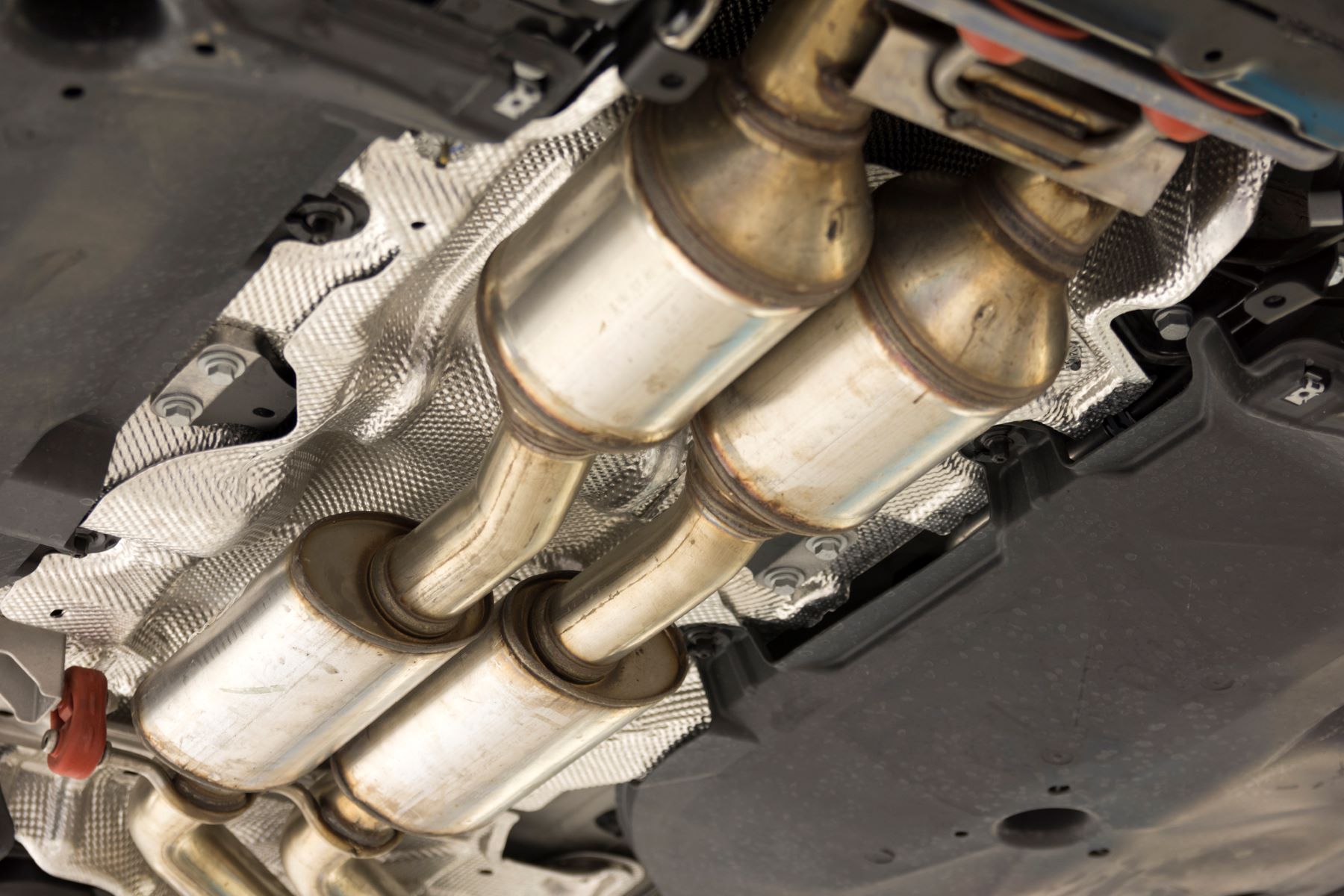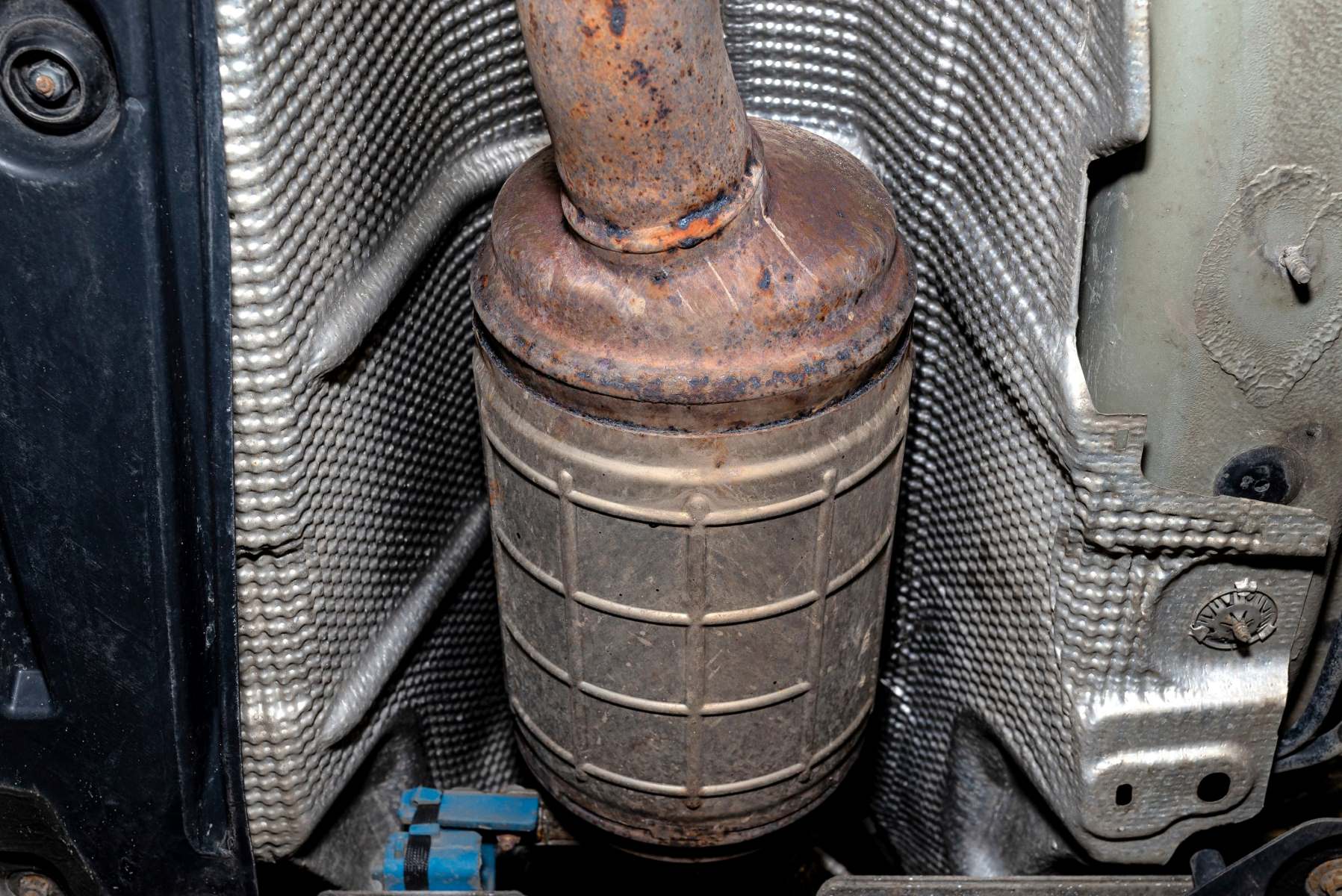Home>Automotive>Quick And Easy Temporary Fix For A Clogged Catalytic Converter


Automotive
Quick And Easy Temporary Fix For A Clogged Catalytic Converter
Published: January 16, 2024
Learn a quick and easy temporary fix for a clogged catalytic converter in your automotive vehicle. Get back on the road in no time!
(Many of the links in this article redirect to a specific reviewed product. Your purchase of these products through affiliate links helps to generate commission for Regretless.com, at no extra cost. Learn more)
Table of Contents
Introduction
The catalytic converter is an essential component of a vehicle's exhaust system, playing a crucial role in reducing harmful emissions. As a pivotal part of the emission control system, the catalytic converter helps to minimize the environmental impact of vehicle exhaust by converting toxic gases into less harmful substances. However, over time, these converters can become clogged, leading to a range of issues such as reduced engine performance and increased emissions.
Understanding the importance of a properly functioning catalytic converter is vital for vehicle owners. Not only does it contribute to a cleaner environment by reducing harmful pollutants, but it also ensures that the vehicle operates efficiently. Recognizing the signs of a clogged catalytic converter and knowing how to address the issue can help prevent further damage and maintain optimal vehicle performance.
In this article, we will delve into the intricacies of the catalytic converter, explore the telltale signs of a clogged converter, and discuss a quick and easy temporary fix that can provide relief while awaiting professional assistance. By gaining a deeper understanding of the catalytic converter and its maintenance, vehicle owners can take proactive measures to address potential issues and uphold the performance and environmental responsibility of their vehicles.
Understanding the Catalytic Converter
The catalytic converter is a vital component of a vehicle's exhaust system, designed to mitigate the environmental impact of harmful emissions. Situated between the engine and the muffler, the catalytic converter is tasked with reducing the level of pollutants released into the atmosphere as a byproduct of the combustion process. This emission control device achieves its function through a series of chemical reactions that transform harmful gases into less harmful substances.
Typically, catalytic converters contain a honeycomb-like structure coated with precious metals such as platinum, palladium, and rhodium. These metals serve as catalysts, facilitating the conversion of toxic gases. When the exhaust gases pass through the catalytic converter, the catalysts initiate chemical reactions that convert carbon monoxide into carbon dioxide, hydrocarbons into carbon dioxide and water, and nitrogen oxides into nitrogen and oxygen.
The conversion process occurs in two main stages: reduction and oxidation. During the reduction stage, the catalysts facilitate the conversion of nitrogen oxides into nitrogen and oxygen. In the subsequent oxidation stage, unburned hydrocarbons and carbon monoxide are converted into carbon dioxide and water. This intricate process effectively reduces the emission of harmful pollutants, making the catalytic converter a critical component for environmental preservation and regulatory compliance.
In addition to its environmental significance, the catalytic converter also plays a pivotal role in vehicle performance. A clogged or malfunctioning converter can lead to reduced engine efficiency, diminished fuel economy, and increased emissions. As such, maintaining the proper function of the catalytic converter is essential for both environmental and vehicular well-being.
Understanding the catalytic converter's function and significance empowers vehicle owners to recognize the importance of regular maintenance and prompt attention to any issues that may arise. By gaining insight into the role of the catalytic converter in emission control and engine performance, individuals can appreciate its impact on environmental sustainability and take proactive measures to ensure its proper operation.
Signs of a Clogged Catalytic Converter
Recognizing the signs of a clogged catalytic converter is crucial for vehicle owners, as it enables them to address potential issues before they escalate. Several indicators can point to a compromised catalytic converter, signaling the need for immediate attention and maintenance. By understanding these warning signs, individuals can take proactive measures to ensure the optimal performance of their vehicles while mitigating the environmental impact of harmful emissions.
-
Decreased Engine Performance: A clogged catalytic converter can impede the flow of exhaust gases, leading to decreased engine performance. Vehicle owners may notice a reduction in power during acceleration, sluggishness, or hesitation when pressing the accelerator pedal. This decline in engine performance can be attributed to the restricted exhaust flow caused by the clogged converter.
-
Elevated Exhaust Temperature: A clogged catalytic converter can result in higher exhaust temperatures, often leading to overheating. This increase in temperature may be noticeable when observing the exhaust system, with the converter emitting excessive heat. Additionally, the vehicle's undercarriage or floorboard near the catalytic converter may feel unusually hot to the touch.
-
Unusual Rattling Noises: A clogged catalytic converter can manifest through unusual rattling or vibrating noises originating from the exhaust system. This may indicate that the internal components of the converter, such as the substrate or catalyst, have become dislodged or damaged due to the accumulation of debris or contaminants.
-
Check Engine Light: The illumination of the check engine light on the vehicle's dashboard can be a prominent indicator of a clogged catalytic converter. When the converter becomes obstructed, it can trigger the vehicle's onboard diagnostics system to detect an anomaly in the exhaust emissions, prompting the activation of the check engine light.
-
Elevated Emissions: A clogged catalytic converter can lead to increased emissions of harmful pollutants, as it is unable to effectively convert toxic gases into less harmful substances. This can result in a vehicle failing emissions tests and emitting visibly darker or denser exhaust fumes during operation.
Recognizing these signs of a clogged catalytic converter empowers vehicle owners to take timely action to address potential issues. By remaining vigilant and attentive to the performance and behavior of their vehicles, individuals can uphold the efficiency of their catalytic converters and contribute to environmental sustainability through reduced emissions and optimal engine operation.
Quick and Easy Temporary Fix
When faced with a clogged catalytic converter, a quick and easy temporary fix involves the utilization of a catalytic converter cleaner. This specially formulated cleaner is designed to dissolve and remove carbon deposits, soot, and other contaminants that may be obstructing the converter's internal components. While this solution serves as a temporary measure to alleviate the symptoms of a clogged catalytic converter, it can provide immediate relief and restore some level of performance while awaiting professional diagnosis and repair.
To apply the catalytic converter cleaner, vehicle owners can follow these simple steps:
-
Choose a Quality Catalytic Converter Cleaner: Select a reputable catalytic converter cleaner designed to dissolve carbon deposits and restore the converter's efficiency. It is essential to opt for a high-quality cleaner to ensure effective results and minimize the risk of further complications.
-
Add the Cleaner to the Fuel Tank: With the vehicle parked in a well-ventilated area, pour the recommended amount of catalytic converter cleaner into the fuel tank. It is advisable to follow the manufacturer's instructions regarding the appropriate dosage based on the vehicle's fuel capacity.
-
Drive the Vehicle: After adding the cleaner to the fuel tank, drive the vehicle for an extended period, allowing the cleaner to circulate through the fuel system and reach the catalytic converter. During this driving phase, the cleaner will begin to dissolve carbon deposits and contaminants within the converter, potentially restoring some of its functionality.
-
Monitor Performance: As the cleaner takes effect, monitor the vehicle's performance for any improvements in engine responsiveness, exhaust emissions, and overall operation. While the temporary fix may not entirely eliminate the underlying issue, it can provide temporary relief by mitigating the symptoms of a clogged catalytic converter.
It is important to note that while a catalytic converter cleaner can offer a temporary solution, it is not a substitute for professional diagnosis and repair. Vehicle owners should seek the expertise of a qualified mechanic to thoroughly inspect the catalytic converter and address any underlying issues contributing to the obstruction. Additionally, regular maintenance and adherence to manufacturer-recommended service intervals can help prevent the recurrence of catalytic converter-related issues, ensuring the long-term efficiency and environmental responsibility of the vehicle.
By employing a catalytic converter cleaner as a quick and easy temporary fix, vehicle owners can alleviate the immediate effects of a clogged converter and gain valuable time to arrange professional assessment and resolution. This proactive approach can help minimize the impact of a compromised catalytic converter on engine performance and emissions, contributing to both vehicular efficiency and environmental sustainability.
Precautions and Safety Measures
When addressing issues related to a clogged catalytic converter, it is essential for vehicle owners to observe precautions and safety measures to ensure their well-being and the proper maintenance of their vehicles. While attempting a quick and temporary fix using a catalytic converter cleaner, individuals should prioritize safety and adhere to recommended guidelines to prevent any potential hazards. By following these precautions, vehicle owners can mitigate risks and promote a secure environment for both themselves and their vehicles.
Read more: Quick And Easy Exhaust Manifold Leak Fix!
Ventilation and Inhalation Protection
When adding a catalytic converter cleaner to the fuel tank, it is crucial to perform the task in a well-ventilated area to minimize exposure to fumes and vapors. Inhalation of these substances can be harmful to health, potentially causing respiratory irritation or other adverse effects. Therefore, individuals should ensure adequate ventilation, such as conducting the procedure in an open space or utilizing a ventilation fan, to disperse any fumes that may arise during the application of the cleaner. Additionally, wearing a protective mask or respirator can provide an extra layer of defense against inhalation of potentially noxious vapors.
Skin and Eye Protection
Given the chemical nature of catalytic converter cleaners, it is important to safeguard the skin and eyes against direct contact with the cleaner. Vehicle owners should wear protective gloves to prevent skin exposure and potential irritation. In the event of accidental contact with the skin, it is advisable to wash the affected area thoroughly with soap and water. Moreover, wearing safety goggles or protective eyewear can shield the eyes from potential splashes or fumes, reducing the risk of eye irritation or injury.
Proper Disposal of Materials
After completing the application of the catalytic converter cleaner, individuals should dispose of any used containers or materials in accordance with local regulations and environmental guidelines. This may involve recycling the empty cleaner container or following specific disposal instructions provided by the manufacturer. By adhering to proper disposal practices, vehicle owners can contribute to environmental sustainability and minimize the impact of waste on the ecosystem.
Professional Assessment and Maintenance
While a catalytic converter cleaner can serve as a temporary solution for a clogged converter, it is imperative to seek professional assessment and maintenance to address the underlying issue comprehensively. Vehicle owners should consult a qualified mechanic or automotive technician to inspect the catalytic converter, diagnose any potential obstructions or damage, and perform necessary repairs. Professional expertise ensures thorough evaluation and resolution of the problem, promoting long-term efficiency and reliability of the vehicle's emission control system.
By prioritizing precautions and safety measures during the application of a catalytic converter cleaner, vehicle owners can safeguard their well-being and promote responsible maintenance practices. These measures not only mitigate potential risks associated with the cleaning process but also contribute to environmental consciousness and the overall longevity of the vehicle's emission control components.
Conclusion
In conclusion, the catalytic converter stands as a pivotal component in the emission control system of vehicles, playing a critical role in reducing harmful pollutants and ensuring environmental sustainability. By understanding the function and significance of the catalytic converter, vehicle owners can appreciate its impact on both vehicular performance and environmental responsibility. Recognizing the signs of a clogged catalytic converter is essential for proactive maintenance, enabling individuals to address potential issues promptly and uphold the efficiency of their vehicles.
The manifestation of decreased engine performance, elevated exhaust temperature, unusual rattling noises, the illumination of the check engine light, and increased emissions serves as clear indicators of a compromised catalytic converter. These signs prompt vehicle owners to take timely action, seeking solutions to alleviate the symptoms and restore the converter's functionality. While a quick and easy temporary fix involving the use of a catalytic converter cleaner provides immediate relief, it is crucial to emphasize the importance of professional assessment and maintenance to address the underlying issue comprehensively.
Moreover, observing precautions and safety measures during the application of a catalytic converter cleaner is paramount, ensuring the well-being of individuals and the responsible maintenance of their vehicles. Prioritizing ventilation, inhalation protection, skin and eye protection, and proper disposal of materials promotes a secure environment and contributes to environmental sustainability.
By integrating these insights into their approach to catalytic converter maintenance, vehicle owners can uphold the efficiency of their vehicles, minimize the impact of clogged converters on engine performance and emissions, and contribute to environmental preservation. The proactive recognition of signs, the application of temporary solutions, and the engagement of professional expertise collectively foster a comprehensive and sustainable approach to catalytic converter maintenance, aligning with the commitment to vehicular efficiency and environmental stewardship.













